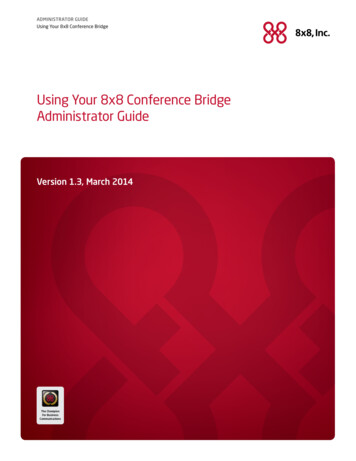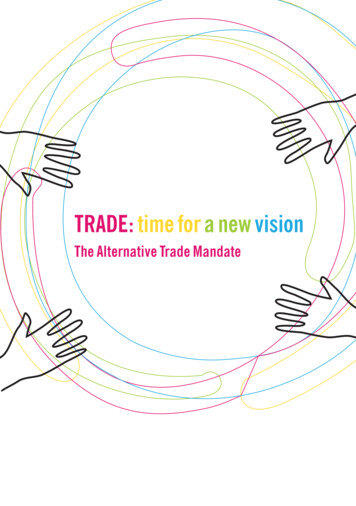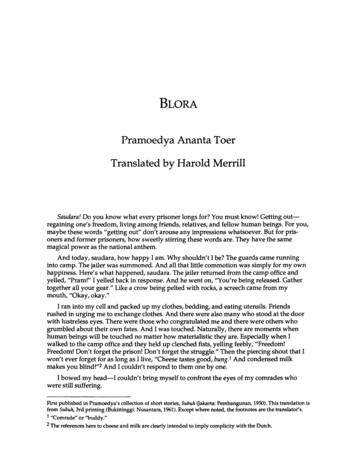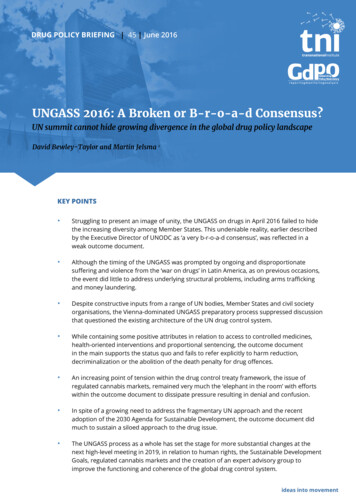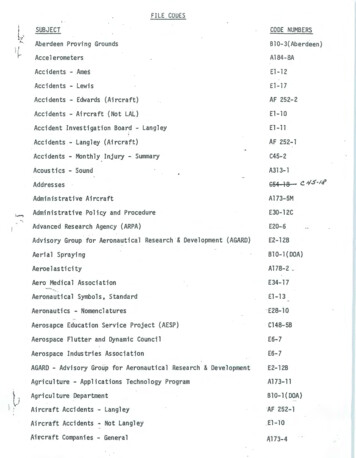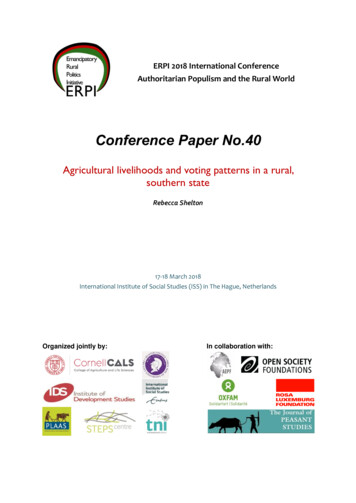
Transcription
ERPI 2018 International ConferenceAuthoritarian Populism and the Rural WorldConference Paper No.40Agricultural livelihoods and voting patterns in a rural,southern stateRebecca Shelton17-18 March 2018International Institute of Social Studies (ISS) in The Hague, NetherlandsOrganized jointly by:In collaboration with:
Disclaimer: The views expressed here are solely those of the authors in their privatecapacity and do not in any way represent the views of organizers and funders of theconference.March, 2018Check regular updates via ERPI website: www.iss.nl/erpi
ERPI 2018 International Conference - Authoritarian Populism and the Rural WorldAgricultural livelihoods and voting patterns in a rural,southern stateRebecca SheltonAcknowledgementsThank you to Sechindra Vallury for his immeasurable assistance with data analysis and Dr. JuliaChrissie Bausch for providing comments on initial drafts of this research.I. IntroductionRecent political shifts in the western world are characterized by an agenda and rhetoric of nationalism- both in economic and ethnographic terms – and exhibit qualities of authoritarian populism. Much ofthe support given to these agendas has come from rural regions, but the forces that motivate thispolitical agency are not entirely clear. Political candidates supersede previously established politicalcategories or parties and gain support through the presentation of anti-institution or anti-statistideologies and personalities while championing the image of a certain kind of “common” people (Hall,1985; Inglehart and Norris, 2016; Scoones et al., 2017). A populist leader often gains support simplyby positioning him/herself as one that is not to blame for negatively received policy outcomes, societalcircumstances, or prior governance decisions and remains able to paint themselves as a victimalongside the people even after they are elected as leaders (Hameleers et al., 2017; Müller, 2017). Thisoften comes at the expense of categorically “othering” different groups of people such that there is anoutlet upon which blame for the current state of affairs can be placed (Hameleers et al., 2017).Blame is an assignment of fault that often stems from coping with stress and stressors that areincongruent with one’s goals (Lazarus and Folkman, 1984; Smith and Kirby, 2010). Stressorsperceived as threats with potential to cause personal harm or loss, and that an individual does not havethe resources (either personal/internal or material resources) to cope with, can result in affectiveresponses of anger or shame which result in externalization or internalization of blame, respectively(Roseman, 1996; Skinner et al., 2003). Thus, societal contexts in which stress and uncontrollablethreats are widespread, may be ripe for authoritarian populist momentum. One form of stress fromwhich populism may arise is, economic stress. The economic inequality perspective argues thatworking class constituents, frustrated by fewer jobs and decreasing income, resent the current momentand align with the blame culture of the authoritarian political movement (Inglehart and Norris, 2016).A second form of stress is that caused by community or cultural change. The cultural backlash theorycontends that populism is fueled by those that wish to resist cultural change and displaced norms(Inglehart and Norris, 2016).Though election results can often be mapped so that urban and rural divides appear, it is critical forresearch to approach and examine the “rural” as a heterogeneous and diverse landscape of peoples(Deavers, 1992; Rye, 2006; Rignall and Atia, 2017). For those unfamiliar with rural communitydynamics, there may be a tendency to imagine rural constituents as those that live and work in small,insulated communities with primary resource industry economies such as farming. However, thoughthe landscape of rural areas is often still visually dominated by and perceived as farming and farmland,there are few rural areas, especially those located outside of the mid-western United States, that arestill economically farm-dependent (Deavers, 1992; USDA-ERS, 2015). Manufacturing, service-sectorjobs, and commutes into urban areas for work have been increasing since the 1970s (USDA-ERS,2009). However, though the majority of rural residents are not economically dependent upon farmincome, farming is still culturally important. Much of the rural landscape is managed by farmers andpermeated with farm identity and, though descendants of farmers may no longer be farming nor livingin the community in which they grew up, they, too, maintain their farm and rural identity (Kayser,1994; Cassidy and McGrath, 2015).1
ERPI 2018 International Conference - Authoritarian Populism and the Rural WorldThis research specifically examines the rise of authoritarian populism in the United States through the2016 presidential election of Donald J Trump. Throughout his campaign (and continued during thepresidency), he used rhetorical tactics of authoritarian populism. As stated by Inglehart and Norris(2016), “His rhetoric peddles a mélange of xenophobic fear tactics (against Mexicans and Muslims),deep-seated misogyny, paranoid conspiracy theories about his rivals, and isolationist ‘America First’policies abroad. His populism is rooted in claims that he is an outsider to D.C. politics, a self-madebillionaire leading an insurgency movement on behalf of ordinary Americans disgusted with thecorrupt establishment, incompetent politicians, dishonest Wall Street speculators, arrogantintellectuals, and politically correct liberals .Hence Trump’s rhetoric seeks to stir up a potent mix ofracial resentment, intolerance of multiculturalism, nationalistic isolationism, nostalgia for past glories,mistrust of outsiders, traditional misogyny and sexism, the appeal of forceful strong-man leadership,attack-dog politics, and racial and anti-Muslim animus.” The “other” was broadly articulated as thosethat pose a threat to security (i.e. terrorists) and also those that take economic advantage of “us,” theelites (Inglehart and Norris, 2016; MacWilliams, 2016). Specifically, this research will seek deeperinsight into the driving forces of politics in the U.S. state of Kentucky, a state in which 62.5% of thevoters elected President Donald J Trump (among the top 5 states in terms of greatest percentage ofvotes won). In addition, the context within the state of Kentucky conceptually aligns with the culturaland economic change arguments that have been previously associated with the rise of authoritarianpopulism. More recently than other states, Kentucky has undergone an agricultural transition awayfrom the culturally and economically important agricultural commodity of tobacco.In the 1960s and 70s, the rural Kentucky economy was largely farming dependent and Kentucky stillcontains the greatest number of farm-dependent communities east of the Mississippi river (USDAERS, 2015; Dimitri et al, 2005). In the early 1990s, approximately two-thirds of Kentucky farms weregrowing tobacco as it was the most profitable cash crop in Kentucky (Snell and Goetz, 1997; Wood,1998). Tobacco accounted for almost 50% of Kentucky’s crop receipts and was grown in 119 out of120 counties (Snell and Goetz, 1997; Shelton, 2018). However, the tobacco economy was based on afederal quota and price support program initiated in the 1930s and, in 2004, driven by changes inconsumption, and in surrender to neoliberalism, the tobacco program was eliminated. Federal and statepolicies have supported farmers through the transition via direct payments to tobacco growers thattook place from 2004-2014 and supported farm enterprise diversification through cost-share and loanprograms (See Shelton, 2018 for more details). Despite these efforts, farm economic adjustments havebeen a challenge and cultural change in farm communities is still evolving.This research will examine economic change in the rural state of Kentucky. In order to account forfarm households that have recently undergone change, this research will examine changes in net farmincome data. However, median income for all households will also be examined given that most ruralhouseholds are no longer dependent on farm income. In addition, as a proxy for cultural change,changes in the number of farmers will also be assessed.Last, in conjunction with economic and cultural change data, presidential election voting data from thelast thirty years is assessed in order to better understand how the 2016 election compared to historicalvoting patterns within Kentucky counties.II. MethodsThis research is based upon analysis of data from public government data sources. Trends in averagenet farm income1, median household income of all families within the selected counties (not just farmfamilies), voting statistics, and community and farmer population are assessed. County level data wasextracted from the U.S. Agriculture Census Database (1987-2012) 2 , U.S. census database for1Net income refers to expenses subtracted from profits. This is average income of the farm operation but doesinclude income from off-farm sources2https://www.agcensus.usda.gov/2
ERPI 2018 International Conference - Authoritarian Populism and the Rural Worldpopulation3 and income4, and the Kentucky government voting database5 for years 1987 to 2016. Theyears included in the analysis were such that farm economics could be evaluated pre and post NAFTAwhich went into effect in 1994. Income data was modified to account for inflation (adjusted toNovember 2017) using the Bureau of Labor statistics CPI inflation calculator6. However, there weresome data limitations as census data is not collected annually and voter data was collected only forpresidential election years. U.S. intercensal estimates were available and used for population andmedian household income data. However, data from the U.S. Agriculture Census is reported every fiveyears and was thus linearly interpolated for in-between years using STATA (STATACorp) beginningfrom 1987 and ending in 20167.In addition, a linear regression was conducted to more explicitly assess covariation between averagenet farm income, farmer community dynamics, and the number of voters in presidential elections thatvoted republican, democrat, or for neither. An OLS regression with community fixed effects at thecounty level (to control for geographic, market, cultural and tobacco quota variation) was run usingSTATA software (STATACorp). The dependent variables were number of votes and the independentvariables included were county population, average net farm income, median household income (tocapture changes in economics in the broader community), number of full-time farmers, number ofpart-time farmers that spend 1-199 days working off-farm, and number of part-time farmers that spendmore than 200 days working off-farm. Due to the fact that presidential election years are only everyfour years, data included in the regression was that for election years 1988, 1992, 1996, 2000, 2004,2008, 2012, and 2016.III. ResultsEconomic ChangeSince 1987, average net farm income has decreased in the Bluegrass, Knobs Arc, and Eastern Coalregions but increased in the western part of the state in the Pennyrile, Western Coal, and JacksonPurchase Regions (Figure 1). Additionally, the range of farm income among counties in all regions,except for the Knobs Arc region, has increased (Figure 1). However, median household income isfairly stable across all regions of the state (Figure 1). This may illustrate that net farm income isincreasingly unimportant for stability in community household economics. However, this data doesshow that household income has, in general, been greatest in the Bluegrass and Knobs Arc regions ofthe state. The Bluegrass region contains two of the state’s largest urban centers – Lexington andLouisville – and the Knobs Arc region boarders the lt.aspx6https://www.bls.gov/data/inflation calculator.htm7Data for 2017 is currently being collected and will be added into the analysis once it is made available in 201843
ERPI 2018 International Conference - Authoritarian Populism and the Rural WorldFigure 1: Average net farm income and median household income by county per region from 1987 to2016.Figure 2: Number of full-time farmers by county in each of Kentucky’s six regions from 1987-2012.4
ERPI 2018 International Conference - Authoritarian Populism and the Rural WorldCultural changeAs of 2012, there were 32,137 principal farm operators that farmed as their primary occupation and44,927 principal farm operators that farmed as a secondary occupation in the state of Kentucky(USDA, 2012). Statistics from the U.S. Agriculture Census database were used in order toquantitatively assess whether the tobacco transition or other economic forces over the last thirty yearshave impacted the number of full and part-time farmers. If the number of full-time farmers decreasedwhile part-time farmers increased, it may suggest seeds from which cultural and lifestyle discontentmight arise within rural communities. Interestingly, in most regions of Kentucky there has been only aslight decline in the number of full-time farmers and in the Western Coal and Jackson Purchaseregions of Kentucky there has been a slight increase (Figure 2). Simultaneously, across all regions,there has been a slight increase in the number of part-time farmers that worked less than 200 days offthe farm (Figure 3) and, on average, a slight decline in the number of farmers that work more than 200days off the farm annually (Figure 4). County population was also examined in order to evaluatewhether rural out-migration, a well-documented phenomenon across the globe, might be occurring inKentucky. Interestingly, trends in county population have been somewhat stable within most regionsexcept the Eastern Coal Region in which there has been some population decline (Figure 5).Figure 3: Number of part-time farmers by county in each of Kentucky’s six regions from 1987-2012that worked less than 200 days off of the farm annually.5
ERPI 2018 International Conference - Authoritarian Populism and the Rural WorldFigure 4: Number of part-time farmers by county in each of Kentucky’s six regions from 1987-2012that worked more than 200 days off the farm annually.Figure 5: County populations per region from 1988-20166
ERPI 2018 International Conference - Authoritarian Populism and the Rural WorldRural population and alignment with TrumpIn order to begin to understand the voter support given to Trump during the 2016 presidential electionand whether or not it might be driven by economic or cultural stress as related to shifts in the size ofthe farming population and/or the amount of time dedicated to farming, voting patterns acrossKentucky were examined for every presidential election since 1988. Since the 1950s, Kentucky’selectoral college has reliably voted Republican. The exception has been when Southern Democratshave run for office such as Lyndon B. Johnson (1964), Jimmy Carter (1976), and Bill Clinton (1992and 1996). Thus, it is important to consider that though voter support for President Trump may havebeen motivated by his authoritarian populist rhetoric, is was likely also affected by the fact that oncehe became the Republican Party’s candidate, voters may have also chosen to support him due to theirloyalty to the Party and the values eschewed by its platform.Figure 6a: Number of republican votes in presidential elections from 1988-2016 per county by region(does not include Bluegrass region due to scale differences)Since 1987, with the exception of the 1992 and 1996 election, the number of republican votes acrossall regions of Kentucky has steadily increased (Figures 6a,b). Population growth does not seem toconsistently account for this trend (Figure 5). Democratic votes have decreased in the Eastern Coal,Jackson Purchase, and Western Coal regions, increased in the Knobs Arc region, and increased veryslightly in the Bluegrass and Pennyrile regions (Figures 7a,b). Interestingly, non-voters andindependent voters have increased across all six Kentucky regions (Figures 8a,b). Linear regressionswere used in order to preliminarily explore covariation between voting patterns and economic andlivelihood shifts. Three regressions were run keeping the independent variables constant and changingthe dependent variable. Average net farm income, median household income, county population,number of full-time farmers, number of part-time farmers that work less than 200 days off of the farm,and number of part-time farmers that work more than 200 days off the farm were regressed against thenumber of republican, number of democratic, and combined number of independent and registerednon-voters.7
ERPI 2018 International Conference - Authoritarian Populism and the Rural WorldFigure 6b: Number of republican votes in presidential elections from 1988-2016 per county in theBluegrass RegionFigure 7a: Number of Democratic votes in presidential elections from 1988-2016 per county by region(does not include Bluegrass region due to scale differences)8
ERPI 2018 International Conference - Authoritarian Populism and the Rural WorldFigure 7b: Number of Democratic votes in presidential elections from 1988-2016 per county in theBluegrass RegionPopulation was significant in all three regressions (Table 1). The number of part-time farmers thatspend less than 200 days off the farm was significant in two regressions. As the number of these parttime farmers increased, the number of republican votes increased but the number of independent andnon-voters decreased. The number of part-time farmers that spend more than 200 days off the farmwas also significant and was negatively correlated with number of republican votes. These analysesare preliminary8, but the results do not indicate that household economic trends nor average farmincome significantly co-vary with voting patterns at the county level. This is supported by the fact thateconomic and voter trend lines at the regional level are seemingly neither positively nor negativelyaligned (Figures 1, 6a, 6b). These analyses do not suggest why there is an increase in Republican votesin counties where there is an increase in farmers working less than 200 days off the farm. However,though speculative, from the data one might hypothesize that this variation could be related to the factthat farmers that were previously full-time have been forced to seek off-farm work and, subsequently,are discontent. An additional hypothesis drawn from the negative covariation between part-timefarmers that work 200 or more days off the farm and number of Republican votes is that theseindividuals are less affected by rural economic shifts because they have not been principally dependenton farm income. They may be those that live on farms primarily in order to pursue a lifestyle in thecountry rather than an economic enterprise. In order to understand if the 2016 presidential electionwas different from historical co-variation between income and farmer status and voting patterns, thesame regression models were run excluding 2016 data (Table 2). Farm income becomes a marginallysignificant predictor for number of Republican votes but the coefficient is close to zero. Also, thenumber of full-time farmers becomes a significant predictor of Republican votes. Thus, one mighthypothesize, that in the 2016 election, those who switched into voting Republican were not farmers,but other rural residents thus diluting the relationship between number of full-time farmers andnumber of Republican votes.8Does not yet include updated farm income data. Relies on interpolated data from 2012. U.S. Agriculturalcensus will release income data from 2017 in 2018.9
ERPI 2018 International Conference - Authoritarian Populism and the Rural WorldFigure 8a: Number of independent party voters added to the number of registered voters that did notvote in the 1988-2016 presidential elections per county by region (does not include Bluegrass regiondue to scale differences)Figure 8b: Number of independent party voters added to the number of registered voters that did notvote in the 1988-2016 presidential elections in the Bluegrass RegionIV. DiscussionThere is some evidence to suggest that those that voted for Trump may have done so due to hisaffiliation with the Republican platform, but there is not clear evidence to suggest that farmers casttheir vote for Trump purely from a place of economic disaffection. Trump’s populist style and position10
ERPI 2018 International Conference - Authoritarian Populism and the Rural Worldas the Republican candidate may have appealed to a wider range of voters than if he had been only oneor the other. Interestingly, during the 2016 Presidential campaign both the Republican and DemocraticParties had an “outsider” candidate: Donald J Trump and Bernie Sanders. Though different in manyways, specifically in that Trump articulated blame not only on elitist politics but also againstimmigrants, they were also similar. They emotionally channeled the anger and frustration of theAmerican and they both spoke openly about the fact that the government has been catering to biginterests rather than the American people, especially blue-collar workers (Gillies, 2017). Thesesimilarities support the idea that there were certain espoused values and candidate characteristics thatspecifically inspired Americans to vote for Trump as, according to an analysis of the CooperativeCongressional Election Study, Brian Schaffner, a political scientist, tweeted that 12% of those thatvoted for Bernie Sanders during the primary election cycle, then voted for Trump in the generalelection9 suggesting some kind of candidate substitutability.Table 1. Number of votes model estimates (data years t No VoteCounty 3)(3.536)Ipartfarmers .608)Constant-1,970.505797.1457,352.430(1,599.039) s: Standard errors in parentheses, * p 0.1 ** p 0.05; *** p 0.01.Economy and CultureAverage net farm income has decreased for some regions of Kentucky but trends in median householdincome have stayed fairly steady. Though economic inequalities do exist, as is seen between medianhousehold income levels of Kentucky regions that host major urban centers of the state (the BluegrassRegion) and other regions, these trends are not new nor strongly impacted by changes in average netfarm income at the aggregate county level. In addition, neither average net farm income nor medianhousehold income co-vary with the number of Republican votes. Proportionate to the population, thereis a lesser increase in Republican votes in the Bluegrass Region when compared to the other regions inKentucky, but in addition to income levels, the demographics and culture in the two most urbancounties contained within this region are different when compared to the rest of the state. Schaffner etal. (2017) examined the influence of economic dissatisfaction, racism, and sexism on voter choices inthe 2016 Presidential election and also found that economic conditions played a minor role incomparison to other cultural factors.However, the quantitative analysis may have missed nuances in economic circumstances given that itwas made at an aggregated level (county for regressions and regional fitted trends). First, overallhousehold income of farmers could be decreasing while that of others living in the county may beincreasing. Second, the presented income statistics do not capture how many hours of work, how9https://twitter.com/b schaffner/status/900123993897926661?lang en11
ERPI 2018 International Conference - Authoritarian Populism and the Rural Worldmany jobs, or how many farm enterprises a farmer must undertake in order to maintain income;farmers may be working a lot harder and longer for the same amount of profit. Third, though it hasbeen made clear that there are urban-rural divides in the United States, what may also be emerging arefractures and divides that run through rural communities.One such internal community divide that is economic but was not explored in this analysis, is thedivide between those who do and do not receive government assistance. According to a 2012 report,Kentucky was among the five states that received the largest share transfers from the federalgovernment for government assistance programs (Miller and Ku, 2014) and, in general, a higherpercentage of rural residents benefit from these programs than urban or suburban residents (Morin etal.). Previous work has found that residents in Eastern Kentucky have low approval for welfareprograms as a means for family subsistence and more strongly support efforts to create jobs (Egan,2000). Similarly, a recent ethnographic study that took place in nine Eastern Kentucky and WestVirginia Counties stated that, “Forms of help and aid that promote dependency among able-bodiedpeople are seen as intensely destructive to individuals, families and the region” (Topos, 2015). Giventhat the Democratic platform is the primary champion for government assistant programs, thisresentment internal to rural areas may partially explain why Republican votes have been increasing.In addition, other analyses show that a higher percentage of individuals that are not likely to votereceive government assistance compared to those that are likely to vote. This may correspond to theincrease in non-voters in Kentucky (MacGillis, 2015).Though rural communities may be perceived as economically dependent on specific industries such asfarming or mining, at the household level and from the perspective of individuals within thesecommunities, these industries may be that which give individuals independence (Topos, 2015).Financial independence achieved through hard work is a core cultural norm for parts of rural Kentuckyand other rural regions of the United States (Topos, 2015; Shelton, 2018; Ulrich-Schad and Duncan,2018) and many may feel that this value is being eroded either due to government assistance or jobsthat do not require physical labor. As is illustrated by this example and by other research, culture andeconomy can be intricately linked and an economic loss may also be felt as a cultural loss (UlrichSchad and Duncan, 2018). Greater awareness should be given to the idea that perhaps it is not theamount of income or achieved economic status that is of sole, greatest importance for contentment, asmuch as the kind of daily work through which that status is obtained. The relationship betweenfinances and stress in farming populations is complex (Schulman and Armstrong, 1989; GorgievskiDuijvesteijn et al., 2005). For example, Schulman and Armstrong (1989) found that farm familieswith income between 10,000 and 19,000 had lower levels of stress than high income farm families.The work of farming is vocational in that it is not solely of financial importance to many farmers, butis motivated through pursuit of identity and lifestyle preference (Shelton, 2018; Frank et al., 2011).Though this kind of cultural backlash is distinctly different from that related to “othering” referencesmade about specific races or peoples in Trump’s rhetoric, it may have aligned with the nostalgic ringof, “make America great again.” Therefore, it may not always be useful to draw lines between culturalbacklash and economic disaffection as two distinct phenomena, but to understand, also, the synergybetween them.Government Dis-trustA key element in the success of authoritarian populism with rural constituents and Kentucky farmersmay also be derived from a generalized dis-trust in the government- an attitude that populistcandidates commonly co-opt to provide support for their “outsider” campaign (Canovan, 1999).According to the PEW Research Center, the public’s trust in the government has been declining since1964; it fell steadily during the G.W. Bush administration, reached record lows during the Obamaadministration while, interestingly, showed increases primarily during the Regan and Clintonadministrations – two populist candidates (Pew, 2014). One of the major factors contributing to adecline in trust is the perceived influence of money in politics. In a 2015 survey conducted by thePEW Research Center, the reason cited as the biggest problem in Washington D.C. was the influenceof special interest money on elected officials (Pew, 2015a) and a measurement of the American12
ERPI 2018 International Conference - Authoritarian Populism and the Rural Worldpublic’s agreement with the concept that the government is run by big interests rather than for thebenefit of the people very similarly corresponds to that of general distrust (Pew, 2015b). In support ofan argument that rural Kentucky constituents prefer decreased government interference, the juniorSenator for Kentucky, Rand Paul, is a tea-party member and espouses values of desiring a smallergovernment. Research shows that only 3% of tea-party supporters trust the federal government “mostof the time” (Pew, 2013).Table 2. Number of votes model estimates (data years t No 4(1.547)***(1.749)(2.269)Ipartfarmers tfarmers200-7.265-2.848-18.004(3.694)*(9.116)(10
His populism is rooted in claims that he is an outsider to D.C. politics, a self-made billionaire leading an insurgency movement on behalf of ordinary Americans disgusted with the corrupt establishment, incompetent politicians, dishonest Wall Street speculators, arrogant . which went into effect in 1994. Income data was modified to account .
